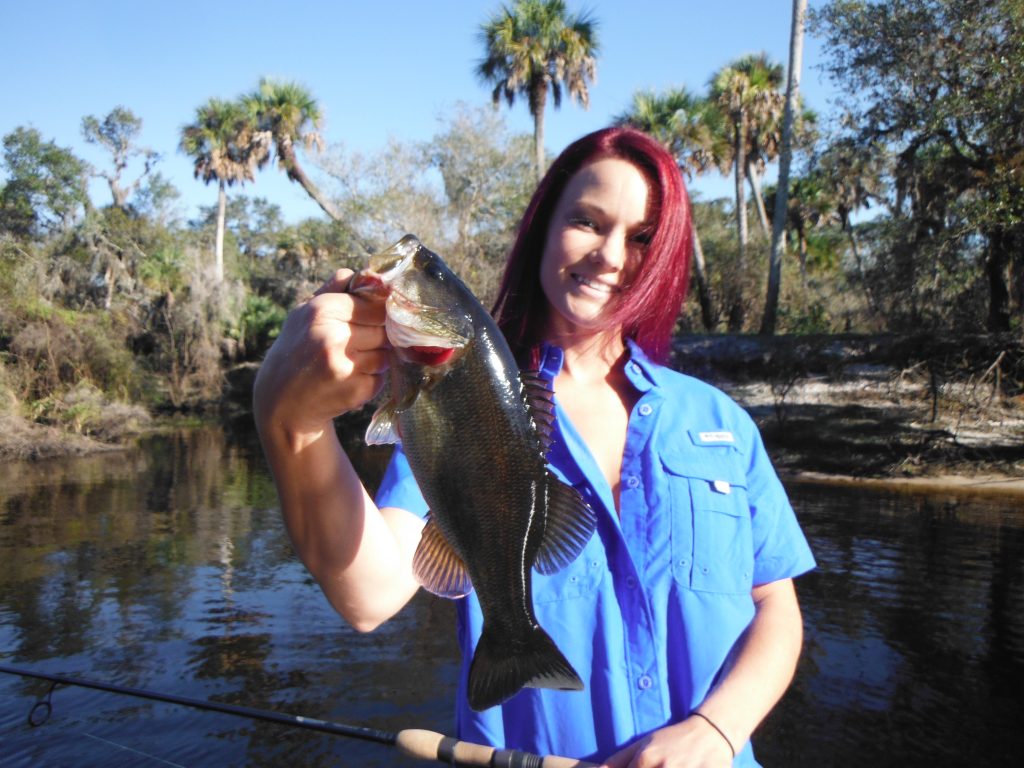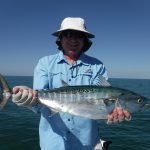Wacky Worm Fishing, Tips and Techniques
This article will thoroughly cover wacky worm fishing. Wacky worm fishing is an easy and productive technique used to present a plastic worm to fish. Largemouth bass are most often the target of anglers using this technique. However, other species can certainly be caught as well.

The wacky worm fishing technique consists of placing a hook through the center of a plastic worm. The worm is usually short, between 4 inches and 6 inches long. As the worm sinks, it undulates very naturally in the water, putting out an action that fish find irresistible. No added weight is used. This is primarily a rig used for largemouth bass fishing.

The hook placement is what separates wacky worm fishing from other types of worms and soft plastic baits. With other rigging methods such as Texas style, Carolina rigging, drop shot, and swim bait hooks, the worm is hooked in the front. This works very well when moving the lure through weeds and over other structure.

Thanks to Jess for the great pics and tips. She never leaves the dock without one outfit rigged up with a wacky worm. Follow Jess on Instagram
Wacky worm fishing techniques
The wacky worm rig is designed to elicit a strike as the worm falls through the water column. The majority of strikes will occur on the cast as the worm slowly sinks, undulating seductively in the water. Anglers can give it a twitch or two after the initial cast as well. It is a form of finesse fishing. However, the worm is not retrieved all the way back in. Instead, it is reeled in quickly and cast to another likely spot.

This approach to wacky worm fishing makes it very efficient. The lure spends its entire time in the strike zone without a lot of wasted time. It allows anglers to concentrate on prime ambush spots while fishing fairly slowly and still covering a fair amount of water at the same time. It sounds a bit contradictory, but in reality this is what makes it such an excellent fishing technique.
Another advantage of wacky worm fishing is at the strike is usually fairly easy to detect. This makes it an excellent choice for novice and beginning anglers. As mentioned above, most strikes occur as the worm falls through the water column. Sometimes the fish just inhales it, but on many occasions the fish just swims off with the worm. This makes it very easy to detect the strike as the line can be seen running out sideways.

Best rods, reels, lines, and hooks
Spinning tackle is preferred by most anglers when wacky worm fishing. There are couple of reasons for this. First off, the worm and hook combination is fairly light. Spinning tackle works best when casting light lures. Also, after the initial cast the bail can be left open allowing the fish to grab the worm and swim off with it without feeling any resistance. After a few moments the bail can be slammed shut and the hook set.

The best rod and reel combination for fishing a wacky worm would be a 7 foot to 7 1/2 foot rod with a fast action paired with a 3000 series reel. A fast action rod means that the rod has a stout butt section but a very limber tip. This allows anglers to cast light lures such as the wacky worm while still having decent power to muscle of fish away from heavy cover.
Click to shop Amazon for a Lew’s Spinning combo
“Fishing Lido Key is a participant in the Amazon Associates Program, an affiliate advertising program designed to provide a means for sites to earn advertising fees by advertising and linking to Amazon. As an Amazon Associate I earn from qualifying purchases. ”
Anglers can use braided line, monofilament line, or fluorocarbon line. It really is just a matter of angler preference. Many anglers prefer braided line is it has zero stretch and excellent sensitivity. A 2 foot long fluorocarbon leader between 10 pound test and 15 pound test should be added, especially in clear water conditions.

A hook completes the wacky worm rig. Most anglers use a wide gap 3/0 to 4/0 finesse style hook. This is a lighter wire hook that is thin, yet strong. A heavy hook does not work well with this finesse type of presentation. Anglers fishing in weedy areas well at times use a hook with a weed guard. Shaky head jig heads are popular as well, as they combine a tiny bit of weight if needed along with a hook and a weed guard. They work very well when fishing slightly deeper water or when current is present.
Fishing the wacky worm
For the most part, wacky worm fishing is a shallow water technique. It is well-suited to fishing depths between 1 foot deep and 6 feet deep. It is an efficient technique that allows anglers to cover a fair amount of water quickly while still fishing slowly. Anglers cast the worm to the high percentage targets such as weed edges, boat docks, submerged timber, and other fish holding spots.

The wacky worm can be fished in deep water, however that is not really it’s strong suit. The rig simply takes too long to sink and it would take anglers a long time to cover an area thoroughly. It is also not the best choice when fishing heavy cover as the design of the rig will result in it hanging on weeds. Texas rigging and Carolina rigging are better options in these situations.
Wacky worm lure options

Just about any plastic worm or other soft plastic bait can be fished wacky style. However, for the most part anglers use a 4 inch to 6 inch finesse type worm. This is sometimes referred to as a do-nothing bait. The reason for this is that the angler does not impart any action but instead allow the subtle actions of the bait to attract fish.
The most popular worm used by anglers wacky worm fishing is by far the Yamamoto Senko worm. This is a fantastic lure that can be rigged wacky style as well as all of the other methods. It comes in 4 inch long and 5 inch long versions and in a wide variety of colors. Green pumpkin is probably the most popular and universal color.

Click to shop Amazon for Senko baits
There are certainly other baits that work well for this technique.They include but are not limited to the Zoom Finesse worm, the General Worm by Berkley, and Yum Dinger worms. Also, any full sized worm can be used when wacky worm fishing. Curly tail worms put out extra action which can at times be more attractive. Larger worms can become more clunky and can tangle. For the most part, the 4″ and 5″ straight worms work best in this application.

Click to shop Amazon for Zoom, General, and Yum Dinger worms
The same philosophies regarding color apply to anglers fishing a wacky worm as well. Natural colors such as green and darker colors such as blue and black work almost anywhere. White and light colors work well in clear water. Hot pink and chartreuse are good choices in water with very low visibility.
Read this article by Capt Jim on soft plastic fishing lures
Wacky worm hooking tips
The best finesse worms for wacky worm fishing are usually very soft and supple. This gives them an excellent lifelike action and the water. However, it also makes them less durable. Therefore, anglers have devised a few different techniques for hooking the wacky worm that will allow anglers to catch more than one fish on each bait.

Wacky worm fishing started by anglers simply putting a hook through the middle of the worm. While this is still effective, it does result in less fish per bait being caught. Some anglers threat the worm through a very short piece of plastic straw, then insert the hook through the straw. O rings can also be used. With this technique, the hook is simply placed under the O-ring and not even piercing the worm. Anglers can purchase kits which have all these components in one location.
In conclusion, this article on wacky worm fishing techniques will help anglers catch more bass!






